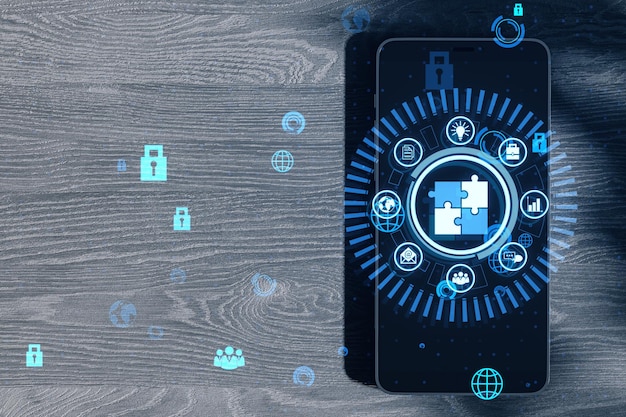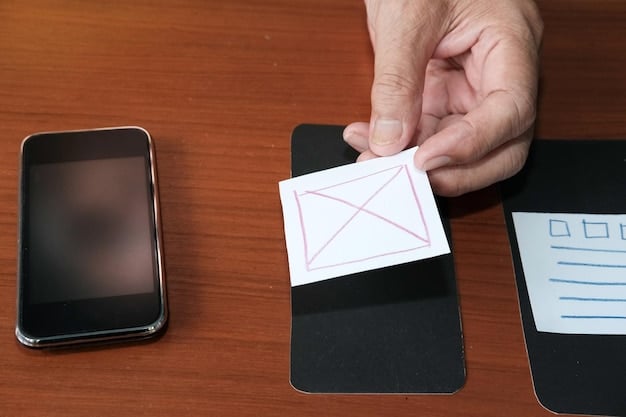Social Media Security: Protect Your Accounts from Hacking Attempts

Social media security is a crucial aspect of online presence, requiring proactive measures such as strong passwords, two-factor authentication, and regular monitoring to safeguard accounts against hacking attempts and data breaches.
In today’s digital age, social media has become an integral part of our lives, connecting us with friends, family, and colleagues. However, this interconnectedness also brings about significant security risks. Understanding and implementing effective social media security measures is essential to protect your accounts from hacking attempts and maintain your online safety.
Why Social Media Security Matters
Social media accounts often contain a wealth of personal information, making them attractive targets for hackers. A compromised account can lead to identity theft, financial loss, and reputational damage. Therefore, taking proactive steps to secure your social media presence is vital.
The Risks of Neglecting Security
Neglecting social media security can have far-reaching consequences. Hackers can use your compromised account to spread malware, phish for sensitive information from your contacts, or even impersonate you to commit fraud. Additionally, your personal data can be exposed, leading to privacy breaches and potential harassment.
Common Hacking Techniques
Understanding common hacking techniques is the first step in protecting yourself. Hackers often use phishing scams, malware, and password cracking methods to gain access to social media accounts. Being aware of these tactics can help you identify and avoid potential threats.
- Phishing Scams: Deceptive emails or messages designed to trick you into revealing your login credentials.
- Malware: Malicious software that can steal your personal information or take control of your account.
- Password Cracking: Using automated tools to guess your password.
By recognizing these risks and common techniques, you can start implementing strategies to strengthen your social media security and protect your valuable personal information.

Strengthening Your Password Security
One of the most fundamental steps in ensuring social media security is creating strong and unique passwords for each of your accounts. A strong password acts as the first line of defense against unauthorized access.
Creating Strong Passwords
A strong password should be at least 12 characters long and include a mix of uppercase and lowercase letters, numbers, and symbols. Avoid using personal information such as your name, birthday, or pet’s name, as these are easily guessable.
Using Password Managers
Password managers can help you generate and store strong passwords for all your online accounts. These tools encrypt your passwords and store them securely, allowing you to easily access them when needed. Popular password managers include LastPass, 1Password, and Dashlane.
- Generate Complex Passwords: Password managers can create unique, strong passwords that are difficult to crack.
- Secure Storage: They store your passwords in an encrypted vault, protecting them from unauthorized access.
- Auto-Fill Feature: Password managers can automatically fill in your login credentials, saving you time and effort.
Employing strong passwords and utilizing password managers can significantly enhance your social media security and reduce the risk of account compromise.
Enabling Two-Factor Authentication (2FA)
Two-factor authentication (2FA) adds an extra layer of security to your social media accounts by requiring a second verification method in addition to your password. This makes it much harder for hackers to gain access, even if they have your password.
How 2FA Works
When you enable 2FA, you’ll need to provide a second form of identification, such as a code sent to your phone via SMS or generated by an authentication app. This ensures that only you can access your account, even if someone else knows your password.
Setting Up 2FA on Social Media Platforms
Most social media platforms offer 2FA as a security option. To enable it, go to your account settings and look for the “Security” or “Privacy” section. Follow the instructions to set up your preferred 2FA method, such as using an authenticator app or receiving SMS codes.
Authenticator Apps vs. SMS Codes
While both authenticator apps and SMS codes provide 2FA, authenticator apps are generally considered more secure. SMS codes can be intercepted, whereas authenticator apps generate unique, time-sensitive codes offline.
- Authenticator Apps: Generate secure, time-based codes. Examples include Google Authenticator and Authy.
- SMS Codes: Send verification codes to your phone via SMS. Convenient but less secure.
By enabling two-factor authentication, you can significantly enhance your social media security and protect your accounts from unauthorized access.
Recognizing and Avoiding Phishing Attempts
Phishing is a common tactic used by hackers to trick you into revealing your login credentials or other sensitive information. Recognizing and avoiding phishing attempts is crucial to maintaining your social media security.

Identifying Phishing Emails and Messages
Phishing emails and messages often contain red flags such as poor grammar, spelling errors, urgent requests, and suspicious links. Be wary of any communication that asks you to click on a link or provide personal information.
Verifying the Sender’s Authenticity
Before clicking on any links or providing any information, verify the sender’s authenticity. Check the sender’s email address to ensure it matches the official domain of the social media platform. If you’re unsure, contact the platform directly to confirm the legitimacy of the communication.
Protecting Yourself from Phishing Scams
To protect yourself from phishing scams, never click on suspicious links, never provide personal information in response to unsolicited requests, and always verify the sender’s authenticity. You can also install anti-phishing software to help detect and block phishing attempts.
- Check Sender’s Email: Ensure the email address matches the official domain of the social media platform.
- Verify Links: Hover over links to see where they lead before clicking.
- Install Anti-Phishing Software: These tools can help detect and block phishing attempts.
Staying vigilant and informed about phishing tactics can greatly improve your social media security and protect you from falling victim to these scams.
Managing App Permissions and Third-Party Access
Many social media apps and websites allow you to connect third-party applications to your accounts. While these integrations can be convenient, they can also pose security risks if not managed properly.
Reviewing App Permissions
Regularly review the permissions you’ve granted to third-party applications. Some apps may request access to sensitive information such as your contacts, location, or private messages. Revoke permissions for apps that you no longer use or trust.
Limiting Third-Party Access
Be cautious about granting third-party applications access to your social media accounts. Only connect apps that you trust and that require the requested permissions. Limit the amount of information you share with these apps to minimize the risk of data breaches.
Revoking Unnecessary Permissions
To revoke unnecessary permissions, go to your account settings on the social media platform. Look for the “Apps” or “Third-Party Access” section. From there, you can review and revoke permissions for each connected app.
- Regularly Review Permissions: Check which apps have access to your account.
- Limit Information Shared: Only share necessary information with trusted apps.
- Revoke Unused Apps: Remove apps you no longer use to reduce security risks.
Properly managing app permissions and third-party access is crucial for maintaining social media security and protecting your personal information from unauthorized access.
Monitoring Your Account Activity
Regularly monitoring your account activity can help you detect and respond to suspicious behavior, such as unauthorized logins or unusual posts. By staying vigilant, you can quickly identify and address potential security threats.
Checking Login History
Most social media platforms provide a login history that shows the dates, times, and locations of recent logins to your account. Review this history regularly to identify any unauthorized access attempts.
Setting Up Activity Alerts
Enable activity alerts to receive notifications when there’s unusual activity on your account, such as a login from a new device or location. This can help you quickly detect and respond to potential security breaches.
Reporting Suspicious Activity
If you notice any suspicious activity on your account, such as unauthorized posts or messages, report it to the social media platform immediately. They can investigate the issue and take steps to secure your account.
- Review Login History: Check for unauthorized access attempts.
- Enable Activity Alerts: Receive notifications for unusual activity.
- Report Suspicious Activity: Alert the platform about potential security breaches.
By actively monitoring your account and responding promptly to suspicious behavior, you can significantly improve your social media security and protect yourself from potential threats.
| Key Point | Brief Description |
|---|---|
| 🔑 Strong Passwords | Use complex, unique passwords for each account. |
| 📱 Two-Factor Authentication | Enable 2FA for an extra layer of security. |
| 🎣 Avoid Phishing | Recognize and avoid phishing scams. |
| 🛡️ Monitor Activity | Regularly check for suspicious activity. |
Frequently Asked Questions
▼
Social media security involves measures to protect your accounts and personal information from unauthorized access, hacking, and other security threats. It includes practices like using strong passwords and enabling two-factor authentication.
▼
Two-factor authentication adds an extra layer of security by requiring a second verification method, making it harder for hackers to access your account even if they have your password. This significantly reduces the risk of unauthorized access.
▼
Phishing attempts often include poor grammar, urgent requests, and suspicious links. Always verify the sender’s authenticity and avoid clicking on links from unknown sources. If in doubt, contact the platform directly.
▼
If your account is hacked, immediately change your password and enable two-factor authentication. Notify the social media platform and your contacts to prevent the spread of malware or phishing scams. Monitor your account activity closely.
▼
You should review your app permissions regularly, ideally every few months. Revoke permissions for apps you no longer use or trust, and limit the information you share with third-party applications to minimize security risks.
Conclusion
Protecting your social media accounts from hacking attempts requires a proactive and multifaceted approach. By implementing strong passwords, enabling two-factor authentication, recognizing phishing scams, managing app permissions, and monitoring your account activity, you can significantly enhance your social media security and safeguard your online presence. Stay vigilant and informed to stay ahead of potential threats.





